Question
A store sells bread and milk. On Tuesday, 8 loaves of bread and 5 litres of milk were sold for $21.40. On Thursday, 6 loaves of bread and 9 litres of milk were sold for $23.40.
If \(b =\) the price of a loaf of bread and \(m =\) the price of one litre of milk, Tuesday’s sales can be written as \(8b + 5m = 21.40\).
Using simplest terms, write an equation in b and m for Thursday’s sales.[2]
Find b and m.[2]
Draw a sketch, in the space provided, to show how the prices can be found graphically.
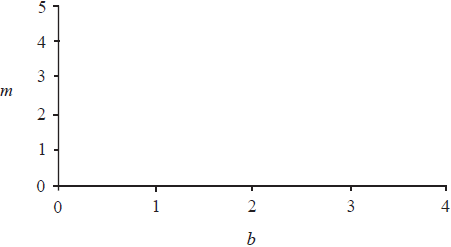 [2]
[2]
Answer/Explanation
Markscheme
Thursday’s sales, \(6b + 9m = 23.40\) (A1)
\(2b + 3m = 7.80\) (A1) (C2)[2 marks]
\(m = 1.40\) (accept 1.4) (A1)(ft)
\(b = 1.80\) (accept 1.8) (A1)(ft)
Award (A1)(d) for a reasonable attempt to solve by hand and answer incorrect. (C2)[2 marks]
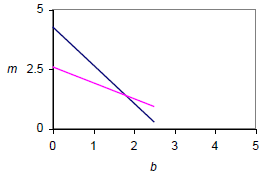 (A1)(A1)(ft)
(A1)(A1)(ft)
(A1) each for two reasonable straight lines. The intersection point must be approximately correct to earn both marks, otherwise penalise at least one line.
Note: The follow through mark is for candidate’s line from (a). (C2)[2 marks]
Question
A plumber in Australia charges 90 AUD per hour for work, plus a fixed cost. His total charge is represented by the cost function C = 60 + 90t, where t is in hours.
Write down the fixed cost.[1]
It takes \(3 \frac{1}{2}\) hours to complete a job for Paula. Find the total cost.[2]
Steve received a bill for 510 AUD. Calculate the time it took the plumber to complete the job.[3]
Answer/Explanation
Markscheme
AUD 60 (A1) (C1)[1 mark]
C = 60 + 90(3.5) = AUD 375 (M1)(A1) (C2)
Note: Award (M1) for correct substitution of 3.5.[2 marks]
Note: Unit penalty (UP) applies in this part
510 = 60 + 90t (M1)(A1)
(UP) t = 5h (hours, hrs) (A1) (C3)
Note: Award (M1) for setting formula = to any number.
(A1) for 510 seen.[3 marks]
Question
The function \(f(x) = 5 – 3({2^{ – x}})\) is defined for \(x \geqslant 0\).
On the axes below sketch the graph of f (x) and show the behaviour of the curve as x increases.[3]
Write down the coordinates of any intercepts with the axes.
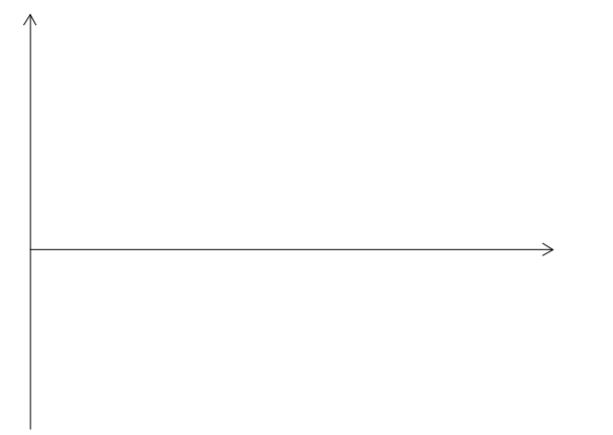 [1]
[1]
Draw the line y = 5 on your sketch.[1]
Write down the number of solutions to the equation f (x) = 5 .[1]
Answer/Explanation
Markscheme
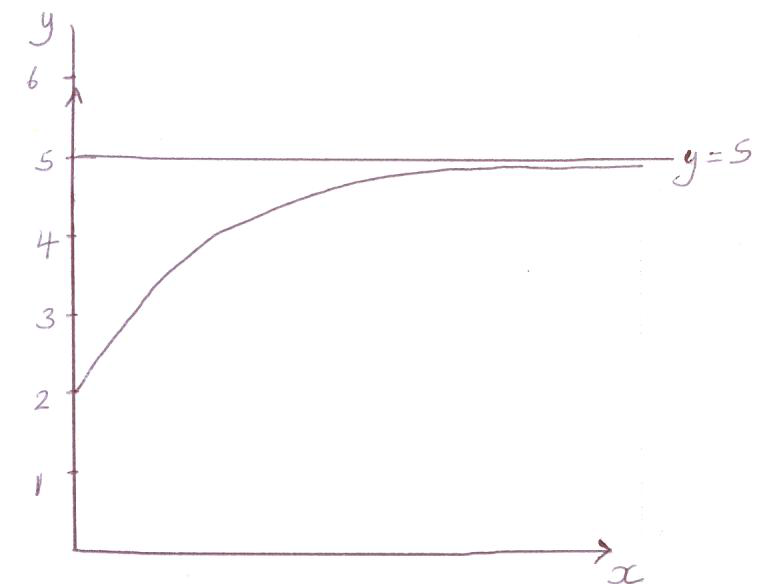 (A1)(A1)(A1)
(A1)(A1)(A1)
Notes: Award (A1) for labels and scale on y-axis.
Award (A1) for smooth increasing curve in the given domain.
Award (A1) for asymptote implied (\({\text{gradient}} \to {\text{0}}\)).
[3 marks]
(0, 2) accept x = 0, y = 2 (A1) (C4)
Note: If incorrect domain used and both (0, 2) and (\( – \)0.737, 0) seen award (A1)(ft).
[1 mark]
line passing through (0, 5), parallel to x axis and not intersecting their graph. (A1) (C1)
[1 mark]
zero (A1) (C1)
[1 mark]
Examiners report
Most candidates attempted this question and many gained 3 or 4 marks. All made an attempt at sketching the graph which demanded that students used their GDC. Many candidates failed to label their graphs and to give an indication of scale, and lost one mark in part (a). Some did not pay attention to the domain and sketched the graph in a different region. A significant number could also write down the coordinates of the y-intercept, although some wrote only y = 2 instead of giving the two coordinates. Almost all could draw the line y = 5 on the sketch but many could not find the answer for the number of solutions to the equation given in part c). Some candidates lost time in an attempt to draw this graph accurately on graph paper, which was not the intended task. Most candidates attempted this question, which clearly indicated that the time given for the paper was sufficient.
Most candidates attempted this question and many gained 3 or 4 marks. All made an attemptat sketching the graph which demanded that students used their GDC. Many candidates failed to label their graphs and to give an indication of scale, and lost one mark in part (a). Some did not pay attention to the domain and sketched the graph in a different region. A significant number could also write down the coordinates of the y-intercept, although some wrote onlyy = 2 instead of giving the two coordinates. Almost all could draw the line y = 5 on thesketch but many could not find the answer for the number of solutions to the equation given in part c). Some candidates lost time in an attempt to draw this graph accurately on graphpaper, which was not the intended task. Most candidates attempted this question, which clearly indicated that the time given for the paper was sufficient.
Most candidates attempted this question and many gained 3 or 4 marks. All made an attemptat sketching the graph which demanded that students used their GDC. Many candidates failed to label their graphs and to give an indication of scale, and lost one mark in part (a). Some did not pay attention to the domain and sketched the graph in a different region. A significant number could also write down the coordinates of the y-intercept, although some wrote onlyy = 2 instead of giving the two coordinates. Almost all could draw the line y = 5 on thesketch but many could not find the answer for the number of solutions to the equation given in part c). Some candidates lost time in an attempt to draw this graph accurately on graphpaper, which was not the intended task. Most candidates attempted this question, which clearly indicated that the time given for the paper was sufficient.
Most candidates attempted this question and many gained 3 or 4 marks. All made an attemptat sketching the graph which demanded that students used their GDC. Many candidates failed to label their graphs and to give an indication of scale, and lost one mark in part (a). Some did not pay attention to the domain and sketched the graph in a different region. A significant number could also write down the coordinates of the y-intercept, although some wrote onlyy = 2 instead of giving the two coordinates. Almost all could draw the line y = 5 on thesketch but many could not find the answer for the number of solutions to the equation given in part c). Some candidates lost time in an attempt to draw this graph accurately on graphpaper, which was not the intended task. Most candidates attempted this question, which clearly indicated that the time given for the paper was sufficient.
Question
Water has a lower boiling point at higher altitudes. The relationship between the boiling point of water (T) and the height above sea level (h) can be described by the model \(T = -0.0034h +100\) where T is measured in degrees Celsius (°C) and h is measured in metres from sea level.
Write down the boiling point of water at sea level.[1]
Use the model to calculate the boiling point of water at a height of 1.37 km above sea level.[3]
Water boils at the top of Mt. Everest at 70 °C.
Use the model to calculate the height above sea level of Mt. Everest.[2]
Answer/Explanation
Markscheme
100 °C (A1) (C1)[1 mark]
\(T = -0.0034 \times 1370 + 100\) (A1)(M1)
Note: Award (A1) for 1370 seen, (M1) for substitution of their h into the equation.
95.3 °C (95.342) (A1) (C3)
Notes: If their h is incorrect award at most (A0)(M1)(A0). If their h = 1.37 award at most (A0)(M1)(A1)(ft).[3 marks]
\(70 = -0.0034h + 100\) (M1)
Note: Award (M1) for correctly substituted equation.
h = 8820 m (8823.52…) (A1) (C2)
Note: The answer is 8820 m (or 8.82 km.) units are required.[2 marks]
Question
Consider the functions \(f(x) = x + 1\) and \(g(x) = {3^x} – 2\).
Write down
(i) the \(x\)-intercept of the graph of \(y = {\text{ }}f(x)\);
(ii) the \(y\)-intercept of the graph of \(y = {\text{ }}g(x)\).[2]
Solve \(f(x) = g(x)\).[2]
Write down the interval for the values of \(x\) for which \(f(x) > g(x)\).[2]
Answer/Explanation
Markscheme
(i) \(( – 1,{\text{ }}0)\) (A1)
Note: Accept \( – 1\).
(ii) \((0,{\text{ }} – 1)\) (A1) (C2)
Note: Accept \( – 1\).
\((x = ){\text{ }} – 2.96{\text{ }}( – 2.96135 \ldots )\) (A1)
\((x = ){\text{ }}1.34{\text{ }}(1.33508 \ldots )\) (A1) (C2)
\( – 2.96 < x < 1.34\;\;\;{\mathbf{OR}}\;\;\;\left] { – 2.96,{\text{ }}1.34} \right[\;\;\;{\mathbf{OR}}\;\;\;( – 2.96,{\text{ }}1.34)\) (A1)(ft)(A1) (C2)
Notes: Award (A1)(ft) for both correct endpoints of the interval, (A1) for correct strict inequalities (or correct open interval notation).
Follow through from part (b).
Question
An iron bar is heated. Its length, \(L\), in millimetres can be modelled by a linear function, \(L = mT + c\), where \(T\) is the temperature measured in degrees Celsius (°C).
At 150°C the length of the iron bar is 180 mm.
Write down an equation that shows this information.[1]
At 210°C the length of the iron bar is 181.5 mm.
Write down an equation that shows this second piece of information.[1]
At 210°C the length of the iron bar is 181.5 mm.
Hence, find the length of the iron bar at 40°C.[4]
Answer/Explanation
Markscheme
\(180 = 150m + c\;\;\;\)(or equivalent) (A1) (C1)
\(181.5 = 210m + c\;\;\;\)(or equivalent) (A1) (C1)
\(m = 0.25,{\text{ }}c = 176.25\) (A1)(A1)(ft)
Note: Follow through from part (a) and part (b), irrespective of working shown.
\(L = 0.025(4) + 176.25\) (M1)
Note: Award (M1) for substitution of their \(m\), their \(c\) and 40 into equation.
\(L = 177\;\;\;(177.25){\text{ (mm)}}\) (A1)(ft) (C4)
Note: Follow through, within part (c), from their \(m\) and \(c\) only if working shown.
Question
The golden ratio, \(r\) , was considered by the Ancient Greeks to be the perfect ratio between the lengths of two adjacent sides of a rectangle. The exact value of \(r\) is \(\frac{{1 + \sqrt 5 }}{2}\).
Write down the value of \(r\)
i) correct to \(5\) significant figures;
ii) correct to \(2\) decimal places.[2]
Phidias is designing rectangular windows with adjacent sides of length \(x\) metres and \(y\) metres. The area of each window is \(1\,{{\text{m}}^2}\).
Write down an equation to describe this information.[1]
Phidias designs the windows so that the ratio between the longer side, \(y\) , and the shorter side, \(x\) , is the golden ratio, \(r\).
Write down an equation in \(y\) , \(x\) and \(r\) to describe this information.[1]
Find the value of \(x\) .[2]
Answer/Explanation
Markscheme
i) \(1.6180\) (A1)
ii) \(1.62\) (A1)(ft) (C2)
Note: Follow through from part (a)(i).
\(xy = 1\) (A1) (C1)
\(\frac{y}{x} = r\) OR \(\frac{y}{x} = \frac{{1 + \sqrt 5 }}{2}\) OR equivalent (A1) (C1)
Note: Accept \(\frac{y}{x} = \) their part (a)(i) or (a)(ii).
\({x^2}r = 1\) or eqivalent (M1)
\(x = 0.786\,\,\,(0.78615…)\) (A1)(ft) (C2)
Note: Award (M1) for substituting their part (c) into their equation from part (b). Follow through from parts (a), (b) and (c). Use of \(r = 1.62\) gives \(0.785674…\)
Question
Passengers of Flyaway Airlines can purchase tickets for either Business Class or Economy Class.
On one particular flight there were 154 passengers.
Let \(x\) be the number of Business Class passengers and \(y\) be the number of Economy Class passengers on this flight.
On this flight, the cost of a ticket for each Business Class passenger was 320 euros and the cost of a ticket for each Economy Class passenger was 85 euros. The total amount that Flyaway Airlines received for these tickets was \({\text{14}}\,{\text{970 euros}}\).
The airline’s finance officer wrote down the total amount received by the airline for these tickets as \({\text{14}}\,{\text{270 euros}}\).
Use the above information to write down an equation in \(x\) and \(y\).[1]
Use the information about the cost of tickets to write down a second equation in \(x\) and \(y\).[1]
Find the value of \(x\) and the value of \(y\).[2]
Find the percentage error.[2]
Answer/Explanation
Markscheme
\(x + y = 154\) (A1) (C1)[1 mark]
\(320x + 85y = 14\,970\) (A1) (C1)[1 mark]
\(x = 8,{\text{ }}y = 146\) (A1)(ft)(A1)(ft) (C2)
Note: Follow through from parts (a) and (b) irrespective of working seen, but only if both values are positive integers.
Award (M1)(A0) for a reasonable attempt to solve simultaneous equations algebraically, leading to at least one incorrect or missing value.[2 marks]
\(\left| {\frac{{14270 – 14970}}{{14970}}} \right| \times {\text{ }}100\) (M1)
Note: Award (M1) for correct substitution into percentage error formula.
\( = 4.68(\% ){\text{ }}(4.67601 \ldots ){\text{ }}\) (A1) (C2)[2 marks]
Question
Jashanti is saving money to buy a car. The price of the car, in US Dollars (USD), can be modelled by the equation
\[P = 8500{\text{ }}{(0.95)^t}.\]
Jashanti’s savings, in USD, can be modelled by the equation
\[S = 400t + 2000.\]
In both equations \(t\) is the time in months since Jashanti started saving for the car.
Jashanti does not want to wait too long and wants to buy the car two months after she started saving. She decides to ask her parents for the extra money that she needs.
Write down the amount of money Jashanti saves per month.[1]
Use your graphic display calculator to find how long it will take for Jashanti to have saved enough money to buy the car.[2]
Calculate how much extra money Jashanti needs.[3]
Answer/Explanation
Markscheme
400 (USD) (A1) (C1)[1 mark]
\(8500{\text{ }}{(0.95)^t} = 400 \times t + 2000\) (M1)
Note: Award (M1) for equating \(8500{(0.95)^t}\) to \(400 \times t + 2000\) or for comparing the difference between the two expressions to zero or for showing a sketch of both functions.
\((t = ){\text{ }}8.64{\text{ (months) }}\left( {8.6414 \ldots {\text{ (months)}}} \right)\) (A1) (C2)
Note: Accept 9 months.[2 marks]
\(8500{(0.95)^2} – (400 \times 2 + 2000)\) (M1)(M1)
Note: Award (M1) for correct substitution of \(t = 2\) into equation for \(P\), (M1) for finding the difference between a value/expression for \(P\) and a value/expression for \(S\). The first (M1) is implied if 7671.25 seen.
4870 (USD) (4871.25) (A1) (C3)
Note: Accept 4871.3.[3 marks]
Question
The size of a computer screen is the length of its diagonal. Zuzana buys a rectangular computer screen with a size of 68 cm, a height of \(y\) cm and a width of \(x\) cm, as shown in the diagram.
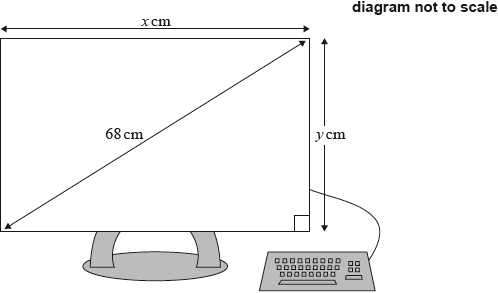
The ratio between the height and the width of the screen is 3:4.
Use this information to write down an equation involving \(x\) and \(y\).[1]
Use this ratio to write down \(y\) in terms of \(x\).[2]
Find the value of \(x\) and of \(y\).[3]
Answer/Explanation
Markscheme
\({x^2} + {y^2} = {68^2}\) (or 4624 or equivalent) (A1) (C1)[1 mark]
\(\frac{y}{x} = \frac{3}{4}\) (M1)
Note: Award (M1) for a correct equation.
\(y = \frac{3}{4}x{\text{ }}(y = 0.75x)\) (A1) (C2)[2 marks]
\({x^2} + {\left( {\frac{3}{4}x} \right)^2} = {68^2}{\text{ }}\left( {{\text{or }}{x^2} + \frac{9}{{16}}{x^2} = 4624{\text{ or equivalent}}} \right)\) (M1)
Note: Award (M1) for correct substitution of their expression for \(y\) into their answer to part (a). Accept correct substitution of \(x\) in terms of \(y\).
\(x = 54.4{\text{ (cm), }}y = 40.8{\text{ (cm)}}\) (A1)(ft)(A1)(ft) (C3)
Note: Follow through from parts (a) and (b) as long as \(x > 0\) and \(y > 0\).[3 marks]
Question
Consider the straight lines L1 and L2 . R is the point of intersection of these lines.
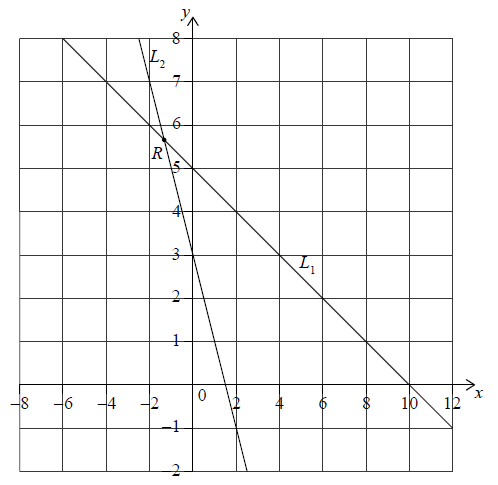
The equation of line L1 is y = ax + 5.
The equation of line L2 is y = −2x + 3.
Find the value of a.[2]
Find the coordinates of R.[2]
Line L3 is parallel to line L2 and passes through the point (2, 3).
Find the equation of line L3. Give your answer in the form y = mx + c.[2]
Answer/Explanation
Markscheme
0 = 10a + 5 (M1)
Note: Award (M1) for correctly substituting any point from L1 into the equation.
OR
\(\frac{{0 – 5}}{{10 – 0}}\) (M1)
Note: Award (M1) for correctly substituting any two points on L1 into the gradient formula.
\( – \frac{5}{{10}}\left( { – \frac{1}{2},\,\, – 0.5} \right)\) (A1) (C2)[2 marks]
\(\left( { – 1.33,\,\,5.67} \right)\,\,\left( {\left( { – \frac{4}{3},\,\,\frac{{17}}{{13}}} \right),\,\,\left( { – 1\frac{1}{3},\,\,5\frac{2}{3}} \right),\,\,\left( { – 1.33333 \ldots ,\,\,5.66666 \ldots } \right)} \right)\) (A1)(ft)(A1)(ft) (C2)
Note: Award (A1) for x-coordinate and (A1) for y-coordinate. Follow through from their part (a). Award (A1)(A0) if brackets are missing. Accept x = −1.33, y = 5.67.[2 marks]
3 = −2(2) + c (M1)
Note: Award (M1) for correctly substituting –2 and the given point into the equation of a line.
y = −2x + 7 (A1) (C2)
Note: Award (A0) if the equation is not written in the form y = mx + c.[2 marks]
Question
On the grid below sketch the graph of the function \(f(x) = 2{(1.6)^x}\) for the domain \(0 \leqslant x \leqslant 3\) .
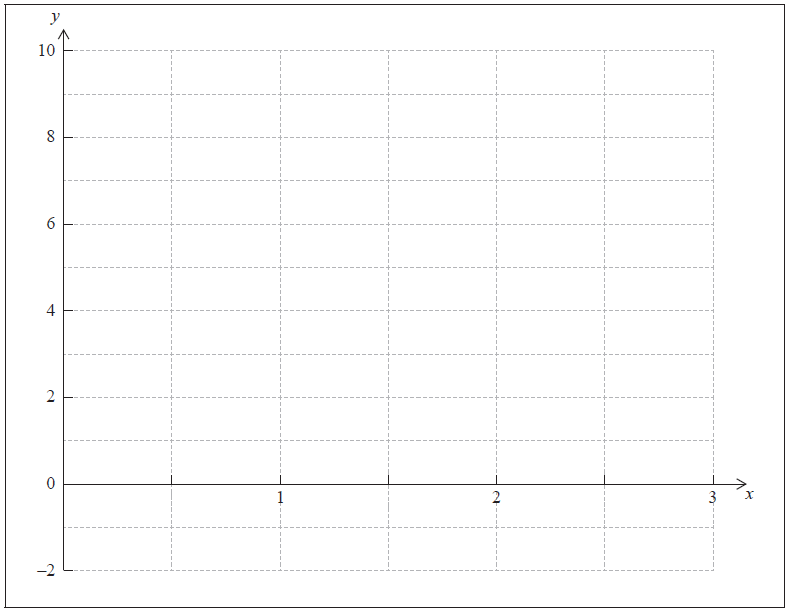 [2]
[2]
Write down the coordinates of the \(y\)-intercept of the graph of \(y = f(x)\) .[1]
On the grid draw the graph of the function \(g(x) = 5 – 2x\) for the domain \(0 \leqslant x \leqslant 3\).[2]
Use your graphic display calculator to solve \(f(x) = g(x)\) .[1]
Answer/Explanation
Markscheme
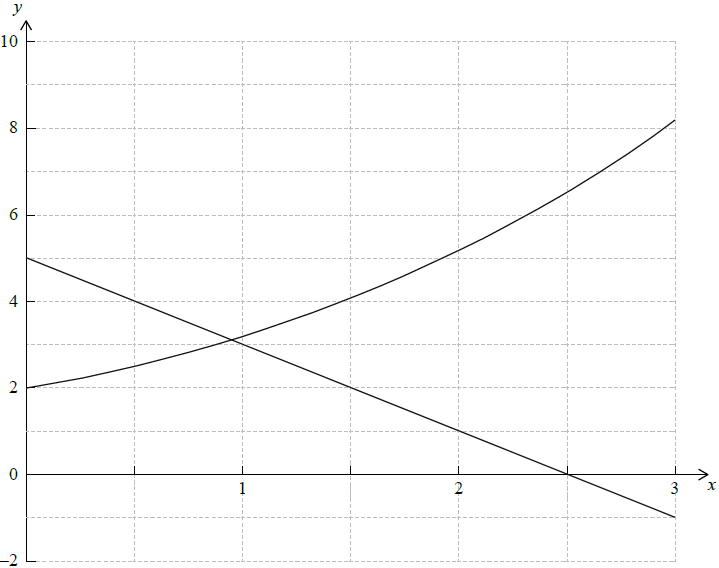
Note: Award (A1) correct endpoints, (A1) for smooth curve. (A1)(A1) (C2)
\((0{\text{, }}2)\) (A1) (C1)
Note: Accept \(x = 0\), \(y = 2\)
Straight line in the given domain (A1)
Axes intercepts in the correct positions (A1) (C2)
\(x = 0.943\) (\(0.94259 \ldots \)) (A1) (C1)
Note: Award (A0) if \(y\)-coordinate given.
Question
A liquid is heated so that after \(20\) seconds of heating its temperature, \(T\) , is \({25^ \circ }{\text{C}}\) and after \(50\) seconds of heating its temperature is \({37^ \circ }{\text{C}}\) .
The temperature of the liquid at time \(t\) can be modelled by \(T = at + b\) , where \(t\) is the time in seconds after the start of heating.
Using this model one equation that can be formed is \(20a + b = 25\) .
Using the model, write down a second equation in \(a\) and \(b\) .[2]
Using your graphic display calculator or otherwise, find the value of \(a\) and of \(b\) .[2]
Use the model to predict the temperature of the liquid \(60{\text{ seconds}}\) after the start of heating.[2]
Answer/Explanation
Markscheme
\(50a + b = 37\) (A1)(A1) (C2)
Note: Award (A1) for \(50a + b\) , (A1) for \(= 37\) .
\(a = 0.4\), \(b = 17\) (A1)(ft)(A1)(ft) (C2)
Notes: Award (M1) for attempt to solve their equations if this is done analytically. If the GDC is used, award (ft) even if no working seen.
\(T = 0.4(60) + 17\) (M1)
Note: Award (M1) for correct substitution of their values and \(60\) into equation for \(T\).
\(T = 41{\text{ }}{{\text{(}}^ \circ }{\text{C}})\) (A1)(ft) (C2)
Note: Follow through from their part (b).

